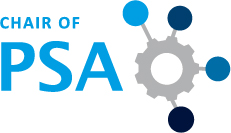Scientific news ticker may 2017
Specialized Book on Multi-Disciplinary Engineering has been published

With the newly published book „Multi-Disciplinary Engineering for Cyber-Physical Produktion Systems“, an analysis of the current state of the art of the model-based design of technical systems, developed by the IAF in cooperation with colleagues from the Vienna University of Technology, is available. The book illustrates the basic questions in the design of products and production systems with regard to the use of descriptive tools and models to the involved engineers. It also introduces solutions that already exist and where questions remain open for further research.
Technical systems in production and beyond are becoming increasingly complex. Accordingly, their design process becomes more and more extensive and significant in the life cycle of these technical systems. This affects the quality and cost of the corresponding design processes.
This situation is aggravated by the fact that production systems are depending on three technical systems: the production system itself, the product to be produced and the production technologies used in the production system. Each of these three components has its own life cycle and its own design methods. However, they are not independent of one another, but rather - as shown in Figure 1 - they define requirements mutually or set the necessary framework conditions.
Figure 1: Relations between product, production system and production technology
As a means to counteract this problem, model-based design methods have become well established in recent years. This assumes that characteristics of the systems to be designed (including construction and behavior) are described by means of software tools on a model basis, which are then to serve as a template for practical implementation. A wide range of tools and models are used by the involved engineers from different disciplines.
This problem is deepened with the increasing use of cyber-physical systems (CPS). This system class is characterized from a design perspective by an increased interlinking of the participating disciplines and thus of the resulting / used models.
With the newly published book "Multi-Discipline Engineering for Cyber-Physical Production Systems", an analysis of the current state of the art for the model-based design of technical systems, developed by IAF in cooperation with colleagues from the Vienna University of Technology, is now available. The book is divided into three major parts, dealing with the topics of product design, production system design and information modeling and integration.
From the IAF's point of view, the following content of the book should be highlighted as it reflects some of the results of current research at the IAF.
In the first chapter of the book, the three editors of the book (Stefan Biffl, TU Vienna, Detlef Gerhard, TU Vienna, and Arndt Lüder, IAF) raise seven fundamental research issues, which will be considered in the next chapters. They refer to the problem areas of modeling, information transfer and the specific requirements of CPS. At the end of the book, it is questioned to what extent the research questions can be regarded as solved and which further research steps make sense.
Chapters 5, 6 and 7 raise the following questions: Which reusable artifacts can be identifiable in production systems? Which information can be assigned to them along the life cycle of the production system? How can they be modelled with regard to information technology? And how can they ultimately be identified in practical applications?
The result is a detailed description of nine distinguishable levels of the component hierarchy of a production system, as well as the depiction of the relevance of these levels for the lifecycle of a production system on the basis of the information quantities or artefacts relevant for this component plane in the corresponding phase, as shown in Figure 2.
Figure 2: Artifact-based assignment of production system components to production system life phases
Chapter 8 discusses the question of changing control architectures for production systems. How could the control architectures change as a result of increasing demands on flexibility and adaptability as well as the increasing use of CPS? How can migration paths look like from the current classical automation pyramid to new type of control architectures? Answers to this, outlined by various research projects, are compiled here.
Chapter 10 deals with the question of the continuous information flow in the engineering of production systems. The main question here is which value a standardized data exchange can have and how a corresponding standardization should take place. Finally, the question is answered as to how AutomationML is positioned as one of the subject areas at the IAF in the context of the standardized data exchange for the engineering of production systems.
The other chapters of the book dealing, for example, with the development of PLM systems or the model quality of design models are also worth reading, so that the book should be seen as a recommendation for further reading and further thinking.
Contact: apl. Prof. Dr.-Ing. habil. Arndt Lüder








